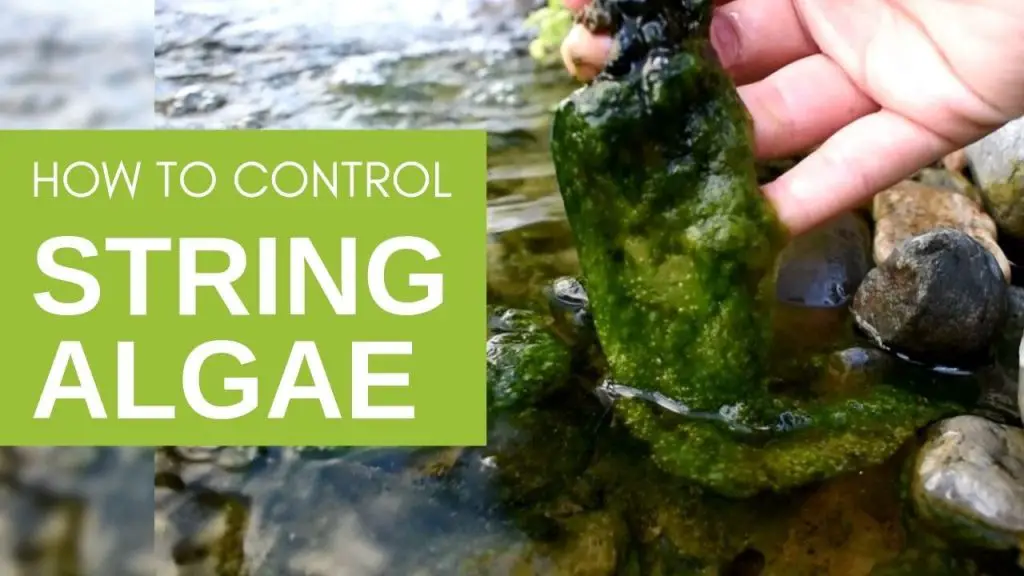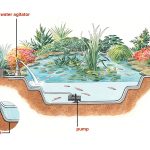String algae, also known as filamentous algae, can quickly take over a fish pond and negatively impact the health of your aquatic life. Not only does it make your pond look unsightly, but it can also deplete oxygen levels and create an unhealthy environment for your fish and plants. If you are dealing with string algae in your fish pond, there are several effective methods you can use to get rid of it and restore the balance in your aquatic ecosystem.
1. Manual Removal
One of the most straightforward ways to control string algae in your fish pond is by manually removing it. Use a pond rake or your hands to gently pull out the algae from the water. Be sure to remove as much of the algae as possible, including the roots, to prevent it from growing back quickly. Regular manual removal can help keep string algae in check and prevent it from spreading further.

Credit: cencalkoi.com
2. Increase Water Circulation
Poor water circulation can contribute to the growth of string algae in your fish pond. By installing a fountain, waterfall, or aerator, you can increase water movement and oxygen levels in the pond, which can help inhibit the growth of algae. The increased circulation will also help distribute beneficial bacteria and nutrients more evenly throughout the pond, promoting a healthier aquatic environment.

Credit: m.youtube.com
3. Add Aquatic Plants
Introducing more aquatic plants to your fish pond can help compete with string algae for nutrients and sunlight, ultimately reducing its growth. Plants such as water lilies, duckweed, and water hyacinth can absorb excess nutrients that fuel algae growth, helping to maintain a balanced ecosystem. Be sure to choose plants that are suitable for your pond size and water conditions to maximize their effectiveness.
4. Use Algae-Eating Fish
Adding algae-eating fish, such as koi, goldfish, or plecos, to your pond can be an effective biological control method for managing string algae. These fish feed on algae and can help keep its population in check. However, be mindful of the fish stocking levels to avoid overloading the pond with nutrients from fish waste, which can potentially worsen the algae problem.
5. Apply Algaecides
If manual removal and natural methods are not sufficient to control string algae in your fish pond, you may consider using algaecides as a last resort. Algaecides are chemical treatments specifically designed to kill algae and inhibit its growth. It is essential to follow the manufacturer’s instructions carefully when using algaecides to ensure the safety of your fish and other aquatic life in the pond.
6. Maintain Proper Water Parameters
Regularly testing and maintaining proper water parameters, such as pH, ammonia levels, and nitrate levels, are crucial for preventing the overgrowth of string algae in your fish pond. Algae thrive in nutrient-rich environments, so keeping these parameters in check can help create an environment that is less favorable for algae growth. Regular water testing and adjustments can help you stay ahead of potential algae issues.
7. Use Barley Straw
Barley straw is a natural and environmentally friendly way to control string algae in fish ponds. When barley straw decomposes in water, it releases compounds that inhibit algae growth. You can place barley straw bales or pellets in your pond to help prevent and reduce algae growth over time. Barley straw is a safe and effective alternative to chemical treatments for controlling algae.
8. Install a UV Clarifier
UV clarifiers are effective tools for controlling string algae in fish ponds by using ultraviolet light to kill algae cells and prevent them from reproducing. By installing a UV clarifier in your pond’s filtration system, you can help keep the water clear and free of algae blooms. UV clarifiers are safe for fish and plants and can be a valuable addition to your pond maintenance routine.
9. Regular Pond Maintenance
Consistent and proper pond maintenance is key to preventing string algae from taking over your fish pond. Regularly remove debris, excess fish waste, and decaying organic matter from the pond to reduce nutrient buildup that can fuel algae growth. Additionally, clean and inspect your pond equipment regularly to ensure proper functioning and optimal water quality.
10. Monitor and Adjust
Monitoring your fish pond regularly and observing changes in water clarity, algae growth, and fish behavior can help you identify issues early on and take corrective actions promptly. By staying proactive and adjusting your pond maintenance routine as needed, you can effectively manage string algae and maintain a healthy and thriving aquatic ecosystem.
Dealing with string algae in your fish pond can be a challenging task, but with the right strategies and consistent maintenance, you can keep it under control and enjoy a beautiful and balanced aquatic environment. Implementing a combination of manual removal, natural controls, and proper maintenance practices can help you effectively combat string algae and create a healthy habitat for your fish and plants.





